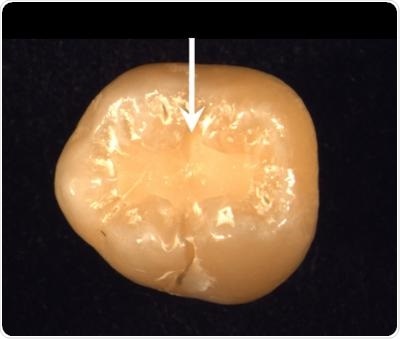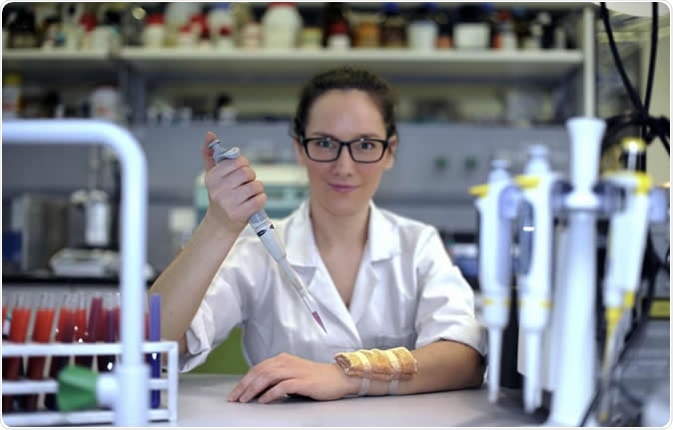
Nanocomposites range between 1‑–100 nm in diameter and are up of ceramic, metal, or polymer. It is imbued with nanoscale fibers or particles to increase catalytic activity, alter physical properties of the material, adjust the refractive index and optical properties, or create superparamagnetic materials.
Silica coated colloidal iron oxide nanoparticles are an example of nanocomposites where all the components are on the nanoscale, rather than the nanoscale component being embedded within a bulk material.

Polymer Matrices
Natural polymers
Natural polymers, such as polysaccharides or proteins, and synthetic polymers can be used to construct the bulk material component of nanocomposites. Polymer matrices are generally preferred to ceramic or metal in a clinical setting due to the lower weight and cost, and a greater flexibility of the material.
Graphene
Nanomaterials such as graphene or carbon nanotubes can be used as reinforcing agents to polymer constructs, which has applications in bone tissue replacement. Low concentrations of carbon nanotubes as a composite material greatly improve compression and flex resistance of a polymer-matrix. Thermal stability can also be improved by the incorporating nanoparticles made from lead, silver or gold.
Electrical and anti-bacterial properties
The electrical properties of a polymer can be fine-tuned by the incorporating metal nanoparticles or other conductive material, such as graphene. In additional to applications in pure electronics, biosensors can detect the presence of glucose or the enzyme glucose oxidase in the blood, which would allow for constant real-time monitoring of blood sugar levels for those with diabetes. Silver nanoparticles have shown evidence of anti-bacterial properties, and implementation into a polymer-matrix allows for their slow release ensuring a maintained anti-bacterial environment able to inhibit the growth of microorganisms upon it.
Ceramic and Metal Matrices
The application of nanocomposites with ceramic or metal matrices in biomedicine is confined to the creation of tough orthopedic or dental implants. Improved corrosion resistance, stress resistance, biocompatibility, hardness and brittleness by incorporating nanomaterial components presents a promising improvement over the materials currently in use.

Nanocomposite Particles
Nanoparticles have found use in the biomedical field for several applications. Metal nanoparticles with large atomic nuclei make excellent contrast agents during X-ray imaging, superparamagnetic nanoparticles such as those made using iron oxide can be used as MRI contrast agents, plasmonic nanoparticles such as those made from gold or silver present optical properties that can be exploited in radiation dose enhancement or diagnostics, and several of these particles make excellent drug delivery agents.
Biological Application
Nanoparticles for use in any biological application must be non-toxic and show minimal bioaccumulation within the body. These properties can be improved by coating these particles with a nanoshell made from materials with low toxicity. Silica is popularly employed for this purpose, coating nanoparticles for safe use in a clinical setting.
Multi-Platform Usage
Interestingly, nanoparticles with different desirable properties can be combined into a single platform. Nanoparticles consisting of an iron oxide core and gold shell have been synthesized to create a multi-platform contrast agent, capable heating via superparamagnetism to release a carried drug payload.
Sources
- Silica-coated Gold Nanoparticles: Surface Chemistry, Properties, Benefits and Applications – www.sigmaaldrich.com/…/silica-coated-gold-nanoparticles.html
- Polymer/metal nanocomposites for biomedical applications – https://www.sciencedirect.com/science/article/pii/S0928493115305543
- Multifunctional gold coated iron oxide core-shell nanoparticles stabilized using thiolated sodium alginate for biomedical applications – https://www.sciencedirect.com/science/article/pii/S0928493116324067
- Ceramic Composites for Biomedical Applications – https://www.sciencedirect.com/science/article/pii/026766059390075I
- Introduction to metallic nanoparticles – https://www.ncbi.nlm.nih.gov/pmc/articles/PMC2996072/
Further Reading
- All Nanotechnology Content
- Nanoscience Advances in Biology
- Bionanotechnology Applications
- What are Nanoelectronic Biosensors?
- Nanoelectronic Biosensor Applications in Human Diseases
Last Updated: Oct 24, 2018

Written by
Michael Greenwood
Michael graduated from Manchester Metropolitan University with a B.Sc. in Chemistry in 2014, where he majored in organic, inorganic, physical and analytical chemistry. He is currently completing a Ph.D. on the design and production of gold nanoparticles able to act as multimodal anticancer agents, being both drug delivery platforms and radiation dose enhancers.
Source: Read Full Article